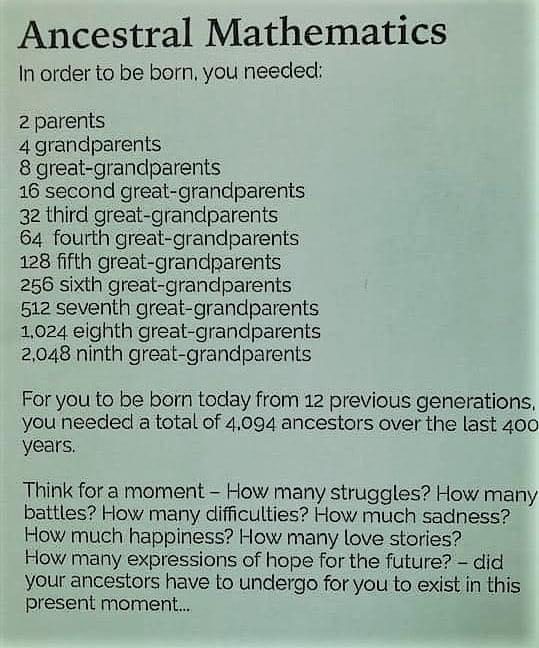
01 Jun Finding your Ancestors- Newsletter- June 4, 2022
Contents
- 1 ANCESTORS THAT DON’T LOOK A DAY OVER 112!
- 2 THE ANCESTORS OF MANY HAWAIIANS, QUEEN LILI’UOKALANI WAS BORN INTO ONE HIGH-RANKING HAWAIIAN FAMILY AND ADOPTED BY ANOTHER
- 3 OUR ANCESTORS FOOLING AROUND LED TO 100 YEARS OF WAR!
- 4 MY ANCESTORS- EVERYONE HAS HEARD OF GOOD KING WENCESLAS THE CHRISTMAS CAROL, BUT WHAT ABOUT HIS NOT SO GOOD MOMMA?
- 5 OUR ANCESTORS HAVING COSMETIC SURGERY IN 1190 A.D.?
- 6 YOUR ANCESTORS ARE WAITING FOR YOU TO DISCOVER THEM!
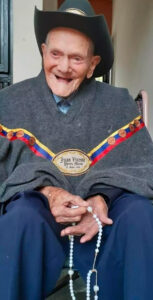 ANCESTORS THAT DON’T LOOK A DAY OVER 112!
ANCESTORS THAT DON’T LOOK A DAY OVER 112!
World’s Oldest Living Man Is Nearly 113, Has 41 Grandchildren and Enjoys a Popular Drink ‘Every Day’
This Venezuelan man is almost 113 years young!
Juan Vicente Pérez Mora, who is 112 years and 355 days old as of Tuesday, was just named the oldest living man by Guinness World Records.
“My dad is in very good health,” daughter Nelyda Perez, one of his 11 children, told the record-keeping organization. “He does not suffer from any disease that requires medical treatment.”
“The whole family is very grateful,” she added.
The supercentenarian, who is the ninth of 10 children, was born on May 27, 1909, according to Guinness.
When he was just 5 years old, he began helping his father and brothers harvest sugar cane and coffee — instilling a life-long love for agriculture.
Read more: https://people.com/human-interest/worlds-oldest-living-man-is-nearly-113-and-has-41-grandchildren/
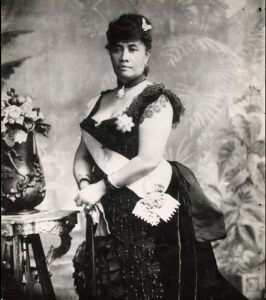
THE ANCESTORS OF MANY HAWAIIANS, QUEEN LILI’UOKALANI WAS BORN INTO ONE HIGH-RANKING HAWAIIAN FAMILY AND ADOPTED BY ANOTHER
Liliʻuokalani’s birth parents were Chief Caesar Kapaʻakea and Chiefess Analea Keaohokāhole, who had been an advisor to King Kamehameha III. When Liliʻuokalani was born, a practice called hānai was prevalent among Native Hawaiians: Children born into large families were often unofficially adopted by families with few or no children. Shortly after her birth, Liliʻuokalani, who had at least six biological siblings, was adopted by High Chief Abner Pākī and his wife, Laura Kōnia, the granddaughter of Kamehameha I. The couple had one biological daughter, Bernice.
“I knew no other father or mother than my foster-parents, no other sister than Bernice,” Liliʻuokalani wrote in her 1898 memoir Hawaii’s Story. “[W]hen I met my own parents, it was with perhaps more of interest, yet always with the demeanor I would have shown to any strangers who noticed me.”
Facts About Liliʻuokalani, Hawaii’s Last Monarch (mentalfloss.com)
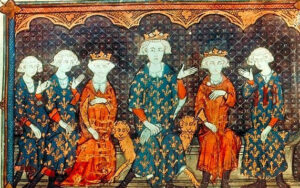 OUR ANCESTORS FOOLING AROUND LED TO 100 YEARS OF WAR!
OUR ANCESTORS FOOLING AROUND LED TO 100 YEARS OF WAR!
** The Tour de Nesle affair was a scandal amongst the French royal family. The royal scandal occurred at the end of the difficult reign of Philip IV, known as “le Bel” (the Fair) because of his good looks. Philip IV had three sons, Louis, Philip and Charles. As was customary for the period, all three were married with an eye for political gain. Initially, Philip had intended Louis to marry Joan, the eldest daughter of Otto IV, Count of Burgundy, but in the end chose Margaret, the daughter of Robert II, Duke of Burgundy, in 1305, and arranged for his middle son Philip to marry Joan in 1307. His youngest son Charles married Blanche, another of Otto’s daughters, in 1308.
The three marriages had fared differently. Louis’ is considered to have been an unhappy match; Louis, known as “the Quarreler” and “the Headstrong”, is said to have preferred playing real tennis to spending time with the “feisty and shapely” Margaret. Charles, a relatively conservative, “strait-laced” and “stiff-necked” individual, had an unexceptional marriage. Philip, in contrast, became noted for his unusual generosity to his wife Joan; the pair had a considerable number of children in a short space of time and Philip wrote numerous, if formulaic, love letters to his wife over the years.
Most accounts of the scandal begin with the visit of the king and queen of England to the queen’s father in France during 1313. Isabella had given new embroidered purses both to her brothers and to their wives. Later in the year, Isabella and Edward held a large dinner in London to celebrate their return and Isabella apparently noticed that the purses she had given to her sisters-in-law were now being carried by two Norman knights, Walter of Aunay and Philip of Aunay. Isabella concluded that the pair must have been carrying on an illicit affair, and appears to have informed her father of this during her next visit to France in 1314.
Philip IV placed the knights under surveillance for a period, and the scandal began to take shape. The accusations centered on suggestions that Blanche and Margaret had been drinking, eating and engaging in adultery with Gautier and Philip of Aunay in the Tour de Nesle over a period. The Tour de Nesle was an old guard tower in Paris next to the river Seine and had been bought by Philip IV in 1308. The third sister-in-law, Joan, was initially said to have been present on some of these occasions and to have known of the affair; later accusations were extended to have included suggestions that she had also been involved in adultery herself.
Following the period of surveillance, Philip IV broke the news of the accusations publicly and arrested all involved. There are some suggestions that Walter and Philip of Aunay attempted to escape to England but in due course both knights were interrogated and tortured by French officials. Both confessed to adultery and were found guilty, therefore, of lèse majesté. Blanche and Margaret were tried before the Paris Parliament and found guilty of adultery. The two women had their heads shaven and were sentenced to life imprisonment.[ Joan was also tried before the Parliament but was found innocent, partially as a result of her husband Philip’s influence.
Having been tortured, the guilty knights Gautier and Philippe were then killed; most histories agree that they were first castrated and then either drawn and quartered or flayed alive, broken on a wheel and then hanged.
Margaret was imprisoned in an underground cell at Château Gaillard castle. Her husband Louis succeeded to the throne later that year after the death of Philip IV, being officially crowned in August 1315. Margaret, however, was still alive and thus became queen of France, but promptly died under suspicious circumstances, possibly murdered, on 14 August, whilst still imprisoned. Louis remarried five days later Louis himself died a year later after falling ill following a challenging game of tennis.
Blanche remained in prison at Château Gaillard as well for eight years until 1322, when Charles assumed the throne and she also technically became queen of France. Upon becoming king, Charles still refused to release Blanche, instead annulling their marriage and having Blanche consigned to a nunnery. Charles remarried immediately afterwards to Marie of Luxembourg; Blanche died the next year, her health broken from the years spent underground.
The affair badly damaged the reputation of women in senior French circles, contributing to the way that the Salic Law was implemented during subsequent arguments over the succession to the throne. When Louis died unexpectedly in 1316, supporters of his daughter Joan found that suspicions hung over her parentage following the scandal and that the French nobility were increasingly cautious over the concept of a woman inheriting the throne – Louis’ brother, Philip took power instead, first as regent pending the birth of Louis’ posthumous child, John, and then as king following that infant’s death within days.
Philip died unexpectedly young as well, and his younger brother Charles did not live long after remarrying after his coronation, similarly dying without male heirs. The interpretation of the Salic Law then placed the French succession in doubt. Despite Philip of Valois, the son of Charles of Valois, claiming the throne with French noble support, Edward III of England, the son of Isabella was able to press his own case, resulting in the ensuing Hundred Years War (1337–1453).
Some of the principal actors in the Tour de Nesle Affair, depicted in 1315, the year after the scandal broke: Philip IV of France (center) and his family: l–r: his sons, Charles and Philip, his daughter Isabella, himself, his eldest son and heir Louis, and his brother, Charles of Valois
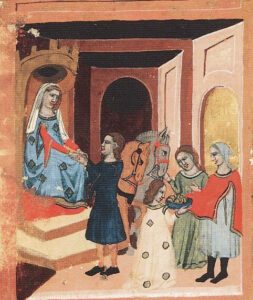 MY ANCESTORS- EVERYONE HAS HEARD OF GOOD KING WENCESLAS THE CHRISTMAS CAROL, BUT WHAT ABOUT HIS NOT SO GOOD MOMMA?
MY ANCESTORS- EVERYONE HAS HEARD OF GOOD KING WENCESLAS THE CHRISTMAS CAROL, BUT WHAT ABOUT HIS NOT SO GOOD MOMMA?
** Ludmila of Bohemia (c. 860 – 15 September 921) is a Czech saint and martyr venerated by the Orthodox and the Roman Catholics. Saint Ludmila was the grandmother of Saint Wenceslaus, who is widely referred to as Good King Wenceslaus. Saint Ludmila was canonized shortly after her death. As part of the process of canonization, in 925, Wenceslaus moved her remains to St. George’s Basilica, Prague.
Wenceslaus’ mother Drahomíra became jealous of Ludmila’s influence over Wenceslaus. She had two noblemen, Tunna and Gommon murder Ludmila in Tetín, and part of Ludmila’s narrative states that she was strangled with her veil.
It is always nice to have a family treasure such as the picture above of my 35th grandmother hiring assassins to kill my saintly great aunt. At first glance, I thought they were giving cookies to the lady visitors!
 OUR ANCESTORS HAVING COSMETIC SURGERY IN 1190 A.D.?
OUR ANCESTORS HAVING COSMETIC SURGERY IN 1190 A.D.?
Dedi III nicknamed the Fat (c. 1130 – 16 August 1190), a member of the House of Wettin, was Margrave of Lusatia from 1185 until his death.
Dedi participated in five campaigns of the Hohenstaufen emperor Frederick Barbarossa to Italy. In 1177, he served as Frederick’s envoy to Pope Alexander III and swore, on Frederick’s behalf, to uphold the Treaty of Venice, which ended the schism between pope and emperor.
Back in Germany, Dedi appears to have spent most of his life in Rochlitz. Like his elder brother Margrave Otto II of Meissen, he encouraged the settlement of ethnic Germans in his territory. He founded Wechselburg Priory as a private monastery, where he and his descendants were buried. Together with his elder brothers Margrave Otto II of Meissen and Margrave Theodoric I of Lusatia, he was a loyal supporter of Emperor Frederick in his conflict with the Welf duke Henry the Lion.
When his brother Theodoric I, who also styled himself a “Margrave of Landsberg”, died in 1185, Dedi inherited his Lusatian possessions and by appointment of Emperor Frederick succeeded him as margrave. In the succession dispute in Meissen upon the death of Margrave Otto II in 1190, Dedi and his sons sided with their cousin Albert the Proud.
In order to get into shape for participating in the Third Crusade, Dedi had his doctors attempt a liposuction. The operation was botched, and as a result, Dedi died on 16 August 1190.
In looking at his sarcophagus (a stone container for a body or coffin) above, he looks in shape. However, maybe the head of the bottom of his robe, is a symbol of his fat trying to crawl away?
Another royal some 50 years later, Henry the Fat (French: Henri le Gros, Spanish: Enrique el Gordo) (c. 1244 – 22 July 1274) was King of Navarre (as Henry I) and Count of Champagne and Brie (as Henry III) from 1270 until his death. His death resulted from being suffocated, by his own fat.

YOUR ANCESTORS ARE WAITING FOR YOU TO DISCOVER THEM!
Reach out to Dancestors and let us research, discover, and preserve your family history. No one is getting any younger, and stories disappear from memory every year and eventually from our potential ability to find them. So do not hesitate, and let’s get on the ball with a call to me @ 214-914-3598.

